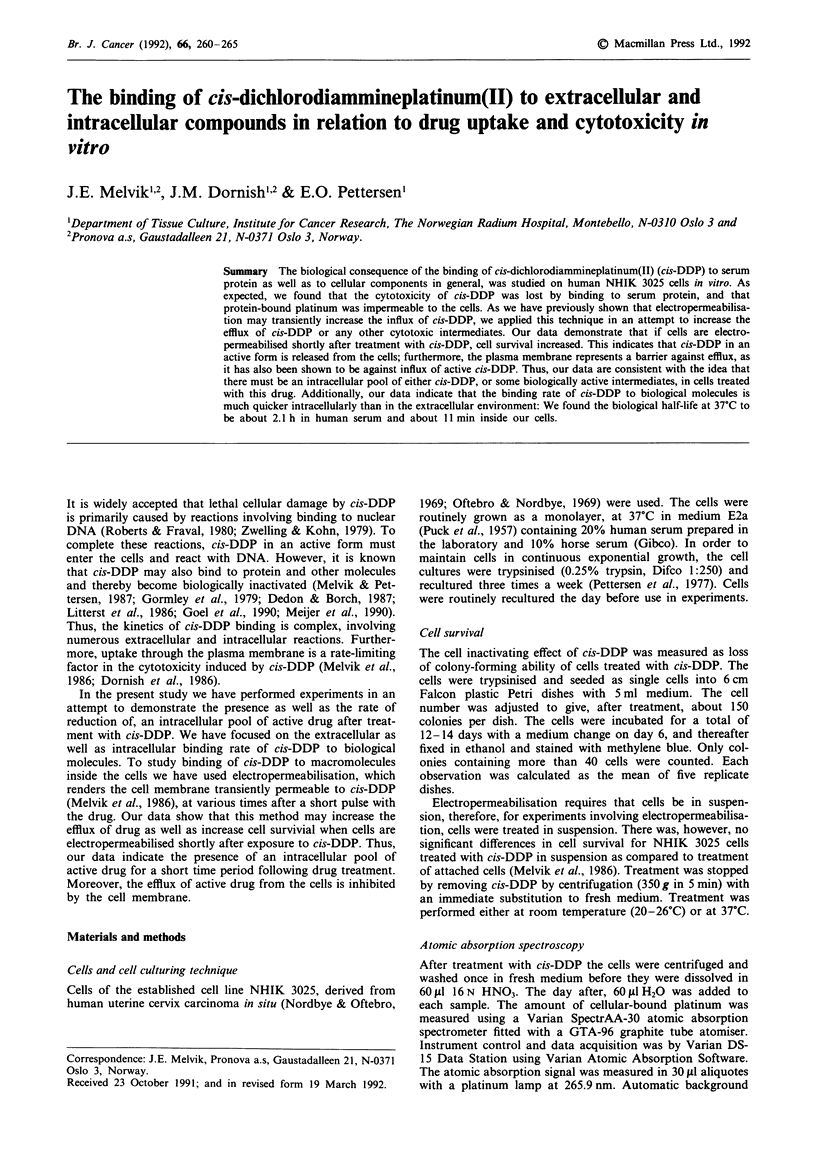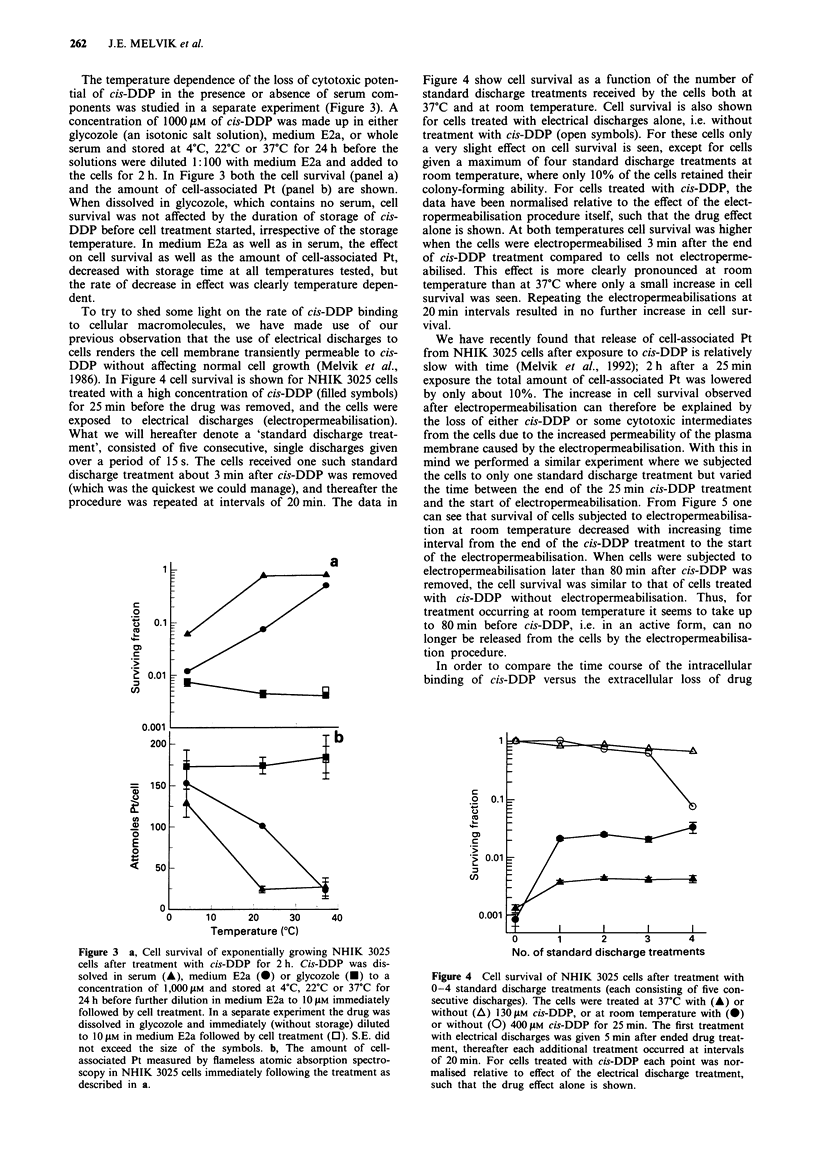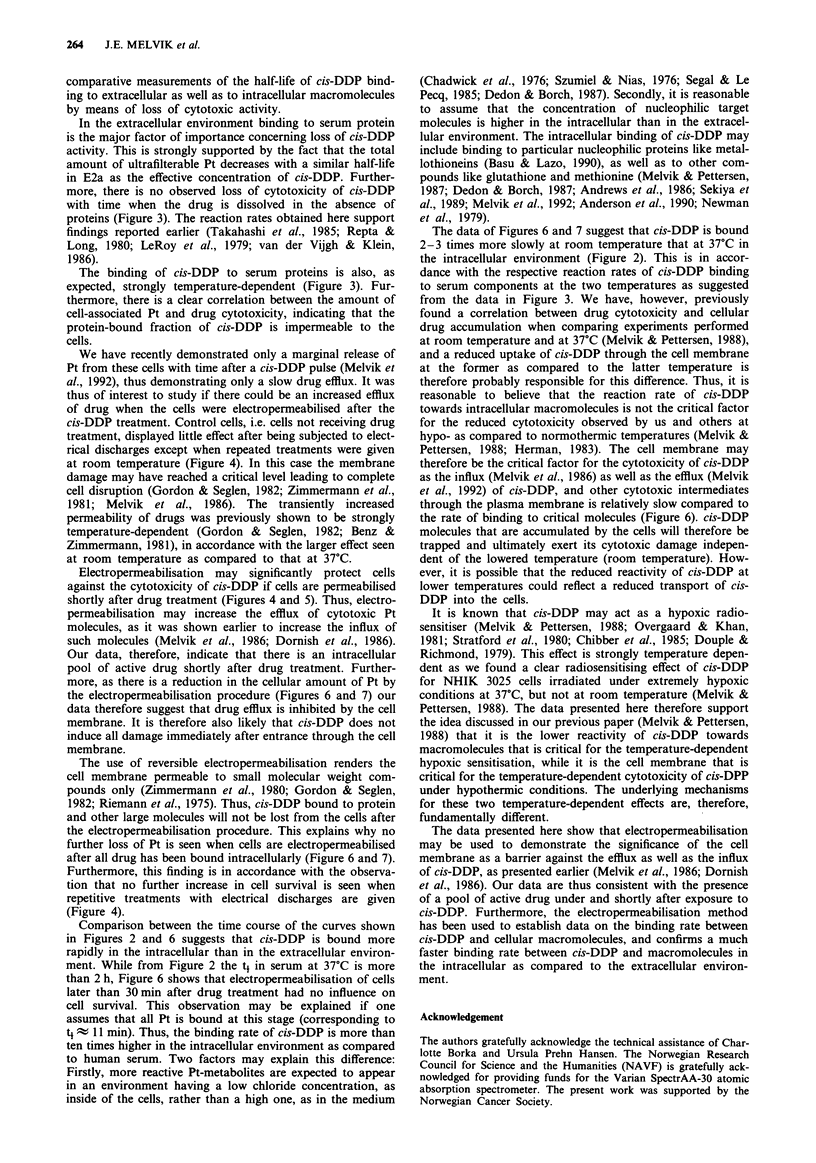Abstract
The biological consequence of the binding of cis-dichlorodiammineplatinum(II) (cis-DDP) to serum protein as well as to cellular components in general, was studied on human NHIK 3025 cells in vitro. As expected, we found that the cytotoxicity of cis-DDP was lost by binding to serum protein, and that protein-bound platinum was impermeable to the cells. As we have previously shown that electropermeabilisation may transiently increase the influx of cis-DDP, we applied this technique in an attempt to increase the efflux of cis-DDP or any other cytotoxic intermediates. Our data demonstrate that if cells are electropermeabilised shortly after treatment with cis-DDP, cell survival increased. This indicates that cis-DDP in an active form is released from the cells; furthermore, the plasma membrane represents a barrier against efflux, as it has also been shown to be against influx of active cis-DDP. Thus, our data are consistent with the idea that there must be an intracellular pool of either cis-DDP, or some biologically active intermediates, in cells treated with this drug. Additionally, our data indicate that the binding rate of cis-DDP to biological molecules is much quicker intracellularly than in the extracellular environment: We found the biological half-life at 37 degrees C to be about 2.1 h in human serum and about 11 min inside our cells.
Full text
PDF





Selected References
These references are in PubMed. This may not be the complete list of references from this article.
- Anderson M. E., Naganuma A., Meister A. Protection against cisplatin toxicity by administration of glutathione ester. FASEB J. 1990 Nov;4(14):3251–3255. doi: 10.1096/fasebj.4.14.2227215. [DOI] [PubMed] [Google Scholar]
- Andrews P. A., Murphy M. P., Howell S. B. Differential sensitization of human ovarian carcinoma and mouse L1210 cells to cisplatin and melphalan by glutathione depletion. Mol Pharmacol. 1986 Dec;30(6):643–650. [PubMed] [Google Scholar]
- Basu A., Lazo J. S. A hypothesis regarding the protective role of metallothioneins against the toxicity of DNA interactive anticancer drugs. Toxicol Lett. 1990 Feb;50(2-3):123–122. doi: 10.1016/0378-4274(90)90002-4. [DOI] [PubMed] [Google Scholar]
- Benz R., Zimmermann U. The resealing process of lipid bilayers after reversible electrical breakdown. Biochim Biophys Acta. 1981 Jan 8;640(1):169–178. doi: 10.1016/0005-2736(81)90542-3. [DOI] [PubMed] [Google Scholar]
- Chadwick K. H., Leenhouts H. P., Szumiel I., Nias A. H. An analysis of the interaction of a platinum complex and radiation with CHO cells using the molecular theory of cell survival. Int J Radiat Biol Relat Stud Phys Chem Med. 1976 Dec;30(6):511–524. doi: 10.1080/09553007614551371. [DOI] [PubMed] [Google Scholar]
- Chibber R., Stratford I. J., O'Neill P., Sheldon P. W., Ahmed I., Lee B. The interaction between radiation and complexes of cis-Pt(II) and Rh(II): studies at the molecular and cellular level. Int J Radiat Biol Relat Stud Phys Chem Med. 1985 Oct;48(4):513–524. doi: 10.1080/09553008514551581. [DOI] [PubMed] [Google Scholar]
- Cole W. C., Wolf W. Preparation and metabolism of a cisplatin/serum protein complex. Chem Biol Interact. 1980 May;30(2):223–235. doi: 10.1016/0009-2797(80)90128-3. [DOI] [PubMed] [Google Scholar]
- Dedon P. C., Borch R. F. Characterization of the reactions of platinum antitumor agents with biologic and nonbiologic sulfur-containing nucleophiles. Biochem Pharmacol. 1987 Jun 15;36(12):1955–1964. doi: 10.1016/0006-2952(87)90494-1. [DOI] [PubMed] [Google Scholar]
- Dornish J. M., Melvik J. E., Pettersen E. O. Reduced cellular uptake of cis-dichlorodiammine-platinum by benzaldehyde. Anticancer Res. 1986 Jul-Aug;6(4):583–588. [PubMed] [Google Scholar]
- Douple E. B., Richmond R. C. Radiosensitization of hypoxic tumor cells by cis- and trans-dichlorodiammineplatinum (II). Int J Radiat Oncol Biol Phys. 1979 Aug;5(8):1369–1372. doi: 10.1016/0360-3016(79)90672-2. [DOI] [PubMed] [Google Scholar]
- Gordon P. B., Seglen P. O. Autophagic sequestration of [14C]sucrose, introduced into rat hepatocytes by reversible electro-permeabilization. Exp Cell Res. 1982 Nov;142(1):1–14. doi: 10.1016/0014-4827(82)90402-5. [DOI] [PubMed] [Google Scholar]
- Gormley P. E., Bull J. M., LeRoy A. F., Cysyk R. Kinetics of cis-dichlorodiammineplatinum. Clin Pharmacol Ther. 1979 Mar;25(3):351–357. doi: 10.1002/cpt1979253351. [DOI] [PubMed] [Google Scholar]
- Hegedüs L., van der Vijgh W. J., Klein I., Kerpel-Fronius S., Pinedo H. M. Chemical reactivity of cisplatin bound to human plasma proteins. Cancer Chemother Pharmacol. 1987;20(3):211–212. doi: 10.1007/BF00570487. [DOI] [PubMed] [Google Scholar]
- Herman T. S. Temperature dependence of adriamycin, cis-diamminedichloroplatinum, bleomycin, and 1,3-bis(2-chloroethyl)-1-nitrosourea cytotoxicity in vitro. Cancer Res. 1983 Feb;43(2):517–520. [PubMed] [Google Scholar]
- LeRoy A. F., Lutz R. J., Dedrick R. L., Litterst C. L., Guarino A. M. Pharmacokinetic study of cis-dichlorodiammineplatinum(II) (DDP) in the beagle dog: thermodynamic and kinetic behavior of DDP in a biologic millieu. Cancer Treat Rep. 1979 Jan;63(1):59–71. [PubMed] [Google Scholar]
- Meijer C., Mulder N. H., Hospers G. A., Uges D. R., de Vries E. G. The role of glutathione in resistance to cisplatin in a human small cell lung cancer cell line. Br J Cancer. 1990 Jul;62(1):72–77. doi: 10.1038/bjc.1990.232. [DOI] [PMC free article] [PubMed] [Google Scholar]
- Melvik J. E., Pettersen E. O., Gordon P. B., Seglen P. O. Increase in cis-dichlorodiammineplatinum (II) cytotoxicity upon reversible electropermeabilization of the plasma membrane in cultured human NHIK 3025 cells. Eur J Cancer Clin Oncol. 1986 Dec;22(12):1523–1530. doi: 10.1016/0277-5379(86)90090-8. [DOI] [PubMed] [Google Scholar]
- Melvik J. E., Pettersen E. O. Oxygen- and temperature-dependent cytotoxic and radiosensitizing effects of cis-dichlorodiammineplatinum(II) on human NHIK 3025 cells in vitro. Radiat Res. 1988 Jun;114(3):489–499. [PubMed] [Google Scholar]
- Overgaard J., Khan A. R. Selective enhancement of radiation response in a C3H mammary carcinoma by cisplatin. Cancer Treat Rep. 1981 May-Jun;65(5-6):501–503. [PubMed] [Google Scholar]
- PUCK T. T., CIECIURA S. J., FISHER H. W. Clonal growth in vitro of human cells with fibroblastic morphology; comparison of growth and genetic characteristics of single epithelioid and fibroblast-like cells from a variety of human organs. J Exp Med. 1957 Jul 1;106(1):145–158. doi: 10.1084/jem.106.1.145. [DOI] [PMC free article] [PubMed] [Google Scholar]
- Pettersen E. O., Bakke O., Lindmo T., Oftebro R. Cell cycle characteristics of synchronized and asynchronous populations of human cells and effect of cooling of selected mitotic cells. Cell Tissue Kinet. 1977 Nov;10(6):511–522. doi: 10.1111/j.1365-2184.1977.tb00309.x. [DOI] [PubMed] [Google Scholar]
- Riemann F., Zimmermann U., Pilwat G. Release and uptake of haemoglobin and ions in red blood cells induced by dielectric breakdown. Biochim Biophys Acta. 1975 Jul 3;394(3):449–462. doi: 10.1016/0005-2736(75)90296-5. [DOI] [PubMed] [Google Scholar]
- Rofstad E. K., Pettersen E. O., Lindmo T., Oftebro R. The proliferation kinetics of NHIK 1922 cells in vitro and in solid tumours in athymic mice. Cell Tissue Kinet. 1980 Mar;13(2):163–171. doi: 10.1111/j.1365-2184.1980.tb00459.x. [DOI] [PubMed] [Google Scholar]
- Segal E., Le Pecq J. B. Role of ligand exchange processes in the reaction kinetics of the antitumor drug cis-diamminedichloroplatinum(II) with its targets. Cancer Res. 1985 Feb;45(2):492–498. [PubMed] [Google Scholar]
- Sekiya S., Oosaki T., Andoh S., Suzuki N., Akaboshi M., Takamizawa H. Mechanisms of resistance to cis-diamminedichloroplatinum (II) in a rat ovarian carcinoma cell line. Eur J Cancer Clin Oncol. 1989 Mar;25(3):429–437. doi: 10.1016/0277-5379(89)90255-1. [DOI] [PubMed] [Google Scholar]
- Stratford I. J., Williamson C., Adams G. E. Combination studies with misonidazole and a cis-platinum complex: cytotoxicity and radiosensitization in vitro. Br J Cancer. 1980 Apr;41(4):517–522. doi: 10.1038/bjc.1980.93. [DOI] [PMC free article] [PubMed] [Google Scholar]
- Szumiel I., Nias A. H. Action of a platinum complex [cis-dichlorobis (cyclopentylamine)-platinum (II)] on Chinese hamster ovary cells in vitro. Chem Biol Interact. 1976 Aug;14(3-4):217–232. doi: 10.1016/0009-2797(76)90102-2. [DOI] [PubMed] [Google Scholar]
- Uchida K., Tanaka Y., Nishimura T., Hashimoto Y., Watanabe T., Harada I. Effect of serum on inhibition of DNA synthesis in leukemia cells by cis- and trans-(Pt (NH3) 2C1(2)). Biochem Biophys Res Commun. 1986 Jul 31;138(2):631–637. doi: 10.1016/s0006-291x(86)80543-5. [DOI] [PubMed] [Google Scholar]
- Zwelling L. A., Kohn K. W. Mechanism of action of cis-dichlorodiammineplatinum(II). Cancer Treat Rep. 1979 Sep-Oct;63(9-10):1439–1444. [PubMed] [Google Scholar]
- van der Vijgh W. J., Klein I. Protein binding of five platinum compounds. Comparison of two ultrafiltration systems. Cancer Chemother Pharmacol. 1986;18(2):129–132. doi: 10.1007/BF00262281. [DOI] [PubMed] [Google Scholar]


